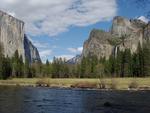Release Date: Nov 7, 2013
Contact(s): Public Affairs Office, (209) 532-3671 ext. 244 or 243
Sonora, Calif...The Stanislaus National Forest has developed a dedicated organization with multiple teams of Forest Service professionals and contractors to plan and implement actions for the Rim Fire recovery effort. Three teams tasked with hazard tree removal, broad scale recovery and rehabilitation of the burned area and reforestation will move quickly towards the analysis of the Rim Fire burned area to allow the most rapid recovery possible of the burned area under the National Environmental Policy Act (NEPA) and evaluate overall restoration needs. These actions will enable urgent work to be completed and other repairs and enhancements to be done in a timely manner. It is anticipated that all necessary decisions will be made by next summer allowing implementation to begin.
The Rim Fire Recovery and Rehabilitation Organization will focus on three main objectives: Move quickly and efficiently, deliver high quality analysis and decisions, and emphasize the importance of public engagement in project development. The overall organization will consist of approximately 55 people with about one third coming from Stanislaus NF employees and the rest drawn from the Forest Service nationwide and contract professionals.
Teams will analyze the Rim Fire area to allow the recovery of burned timber and ensure that the analysis incorporates the most up-to-date scientific information available. During project development a unique public collaboration component will be used to promote public comments and involvement much earlier in the NEPA process to help formulate alternatives.
Dead standing trees must be harvested within 24 months of the fire to be used for lumber. Small trees less than 16 inches in diameter and those left standing longer than 24 months lose their merchantable value. Restoration of the landscape is a priority. The burned area will be evaluated to determine tree mortality and identify areas appropriate for reforestation. Removal of dead trees is considered part of the restoration process when needed to create desirable seedling conditions, mitigate falling tree hazards and reduce fuel buildups.
As Burned Area Emergency Response (BAER) projects that mitigated many of the immediate hazards begin to wind down, work will now shift towards the longer term recovery effort. The Forest has selected two options to proceed under NEPA. An Environmental Impact Statement (EIS) will be used to complete overall recovery efforts including fixing roads, culverts and streamside zones not addressed by BAER work, to capture the value of burned timber, and to treat the burned area to make it more fire resilient in the future. A slightly less complicated analysis, an Environmental Assessment (EA), will be used to mitigate health and safety issues through the removal of hazard trees from critical infrastructure and high level use forest roads.
Expectations are to have a decision on the hazard tree EA by late spring and a decision on the EIS in the summer. The first two teams are moving forward immediately, the third team focusing on reforestation will be stood up as staffing is identified.
Rim Fire Recovery and Rehabilitation Organization
All posts are those of the individual authors and the owner
of this site does not endorse them. Content should be considered opinion
and not fact until verified independently.
Sorry, only registered users may post in this forum.


